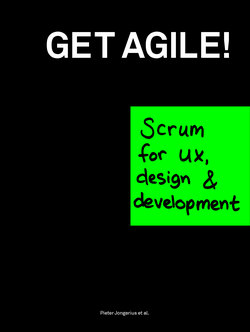Читать книгу Get Agile - Pieter Jongerius - Страница 7
На сайте Литреса книга снята с продажи.
ОглавлениеPreface
When we established Fabrique in 1992, we had been freshly trained at the TU Delft in design methods where we worked step by step from a design brief towards a product. This was a serial approach which we nowadays call the waterfall method: a method that provides a guideline and guarantees results, especially in static and straightforward situations.
In the course of the years, there have been many changes in our work environment. The dynamics in developing digital media, in particular, have increased to a point where a classical approach will no longer do. For one thing, our customers are asking for shorter lead times. Moreover, they increasingly have pertinent expertise themselves, and it is therefore very useful and desirable for them to actively participate instead of just placing an order. On a regular basis, projects are too large for controlled development and documentation, while at the same time keeping up the pace, with conventional methods. And our customers are not only demanding the final result; they also want influence on the journey towards the goal. On top of all that, we are working in a multidisciplinary environment where strategists, interaction and visual designers, copywriters and programmers want to work together. Therefore, it was time to think about a new approach.
In 2008, we got started on Scrum. Through trial and error, we found out that this method offers a very good response to the changing demand in our design practice as well. Since 2008, at Fabrique, through experimentation, evaluation and finetuning we expanded the Scrum method from a software development tool to an integral innovation method in the field of digital media. All this time we were driven by our — admittedly somewhat geeky fascination for the design process.
So, is Scrum the Holy Grail of digital media development? Of course not. Scrum bears certain risks, and the decision to use it must be carefully considered. This aspect is covered in-depth in the book as well.
A book?
Yes, a book. Scrum is a very physical method. You cannot miss it if people are scrumming somewhere: there will be post-its and flip-over sheets all over the place. Therefore, we found it very appropriate to bundle all of our knowledge and experience in an old-fashioned book — another physical object that you can soon have lying about in your Scrum rooms.
We wish you success!
Gert Hans Berghuis
Managing Partner, Fabrique
Fabrique, a multidisciplinary agency, has scrummed for 48 national and international clients since 2008. Our Scrum experience consists of numerous projects for a wide range of industries such as finance, retail, fashion, education, and transport. With 76 Scrum Masters, designers, developers, copywriters, directors and strategists, we scrummed for 56,619 hours, together with product owners, photographers, content managers, technical partners, and stakeholders, in 264 sprints. In that time, we completed 2,361 stories with a total of 30,710 tasks. 30,711… 30,712… 30,713… and counting…
